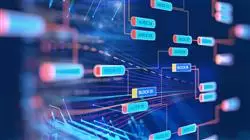University certificate
Scientific endorser

The world's largest faculty of information technology”
Introduction to the Program
Protecting data is key in the face of constant threats. You could be the guardian of that valuable information”

Every second, thousands of pieces of data are generated, shared and stored in the digital environment. From making online payments and accessing educational services to coordinating business activities or protecting digital identities, technology has become an essential pillar that continually transforms the way we live and work. These interactions generate and transfer massive amounts of data at every instant, from personal information to sensitive files related to companies and institutions. This constant flow of data highlights the need for proper handling to ensure its security and privacy.
Managing and protecting this data is no simple task, as it requires the combination of highly specialized expertise in areas such as cybersecurity and information management. These disciplines, although distinct, must be integrated to address the complex challenges of today's digital environment. In this context, the Advanced master’s degree in Secure Information Management represents a unique opportunity for engineers and IT professionals interested in acquiring a comprehensive vision that will enable them to master both areas and position themselves as leaders in a constantly growing sector.
Many companies and institutions face the need to protect critical and highly sensitive data, but lack experts who can ensure effective management, preservation and surveillance of their digital information. To respond to this demand, TECH has designed a program that combines the best content with a teaching team of recognized professional experience. This approach ensures that students acquire the tools and knowledge necessary to stand out in the job market and access strategic positions in organizations seeking to strengthen their information security.
Acquire the skills needed to secure and effectively manage data in a competitive digital environment”
This Advanced master’s degree in Secure Information Management contains the most complete and up-to-date educational program on the market. The most important features include:
- The development of practical cases presented by experts in Secure Information Management
- The graphic, schematic, and practical contents with which they are created, provide scientific and practical information on the disciplines that are essential for professional practice
- Practical exercises where self-assessment can be used to improve learning
- Special emphasis on innovative methodologies in Secure Information Management
- Theoretical lessons, questions to the expert, debate forums on controversial topics, and individual reflection assignments
- Content that is accessible from any fixed or portable device with an Internet connection
Consolidate your theoretical knowledge with the numerous practical resources included in this Advanced master’s degree in Secure Information Management”
The teaching staff includes professionals belonging to the field of Finance, who bring to this program the experience of their work, as well as recognized specialists from leading companies and prestigious universities.
The multimedia content, developed with the latest educational technology, will provide the professional with situated and contextual learning, i.e., a simulated environment that will provide an immersive learning experience designed to prepare for real-life situations.
This program is designed around Problem-Based Learning, whereby the student must try to solve the different professional practice situations that arise throughout the program. For this purpose, the professional will be assisted by an innovative interactive video system created by renowned and experienced experts.
Discover the most innovative educational methodology designed by TECH to guarantee immersive and contextualized learning"

Access a 100% online program that allows you to study at your own pace, at any time and from anywhere in the world"
Why study at TECH?
TECH is the world’s largest online university. With an impressive catalog of more than 14,000 university programs available in 11 languages, it is positioned as a leader in employability, with a 99% job placement rate. In addition, it relies on an enormous faculty of more than 6,000 professors of the highest international renown.

Study at the world's largest online university and guarantee your professional success. The future starts at TECH”
The world’s best online university according to FORBES
The prestigious Forbes magazine, specialized in business and finance, has highlighted TECH as “the world's best online university” This is what they have recently stated in an article in their digital edition in which they echo the success story of this institution, “thanks to the academic offer it provides, the selection of its teaching staff, and an innovative learning method aimed at educating the professionals of the future”
A revolutionary study method, a cutting-edge faculty and a practical focus: the key to TECH's success.
The most complete study plans on the university scene
TECH offers the most complete study plans on the university scene, with syllabuses that cover fundamental concepts and, at the same time, the main scientific advances in their specific scientific areas. In addition, these programs are continuously being updated to guarantee students the academic vanguard and the most in-demand professional skills. In this way, the university's qualifications provide its graduates with a significant advantage to propel their careers to success.
TECH offers the most comprehensive and intensive study plans on the current university scene.
A world-class teaching staff
TECH's teaching staff is made up of more than 6,000 professors with the highest international recognition. Professors, researchers and top executives of multinational companies, including Isaiah Covington, performance coach of the Boston Celtics; Magda Romanska, principal investigator at Harvard MetaLAB; Ignacio Wistumba, chairman of the department of translational molecular pathology at MD Anderson Cancer Center; and D.W. Pine, creative director of TIME magazine, among others.
Internationally renowned experts, specialized in different branches of Health, Technology, Communication and Business, form part of the TECH faculty.
A unique learning method
TECH is the first university to use Relearning in all its programs. It is the best online learning methodology, accredited with international teaching quality certifications, provided by prestigious educational agencies. In addition, this disruptive educational model is complemented with the “Case Method”, thereby setting up a unique online teaching strategy. Innovative teaching resources are also implemented, including detailed videos, infographics and interactive summaries.
TECH combines Relearning and the Case Method in all its university programs to guarantee excellent theoretical and practical learning, studying whenever and wherever you want.
The world's largest online university
TECH is the world’s largest online university. We are the largest educational institution, with the best and widest online educational catalog, one hundred percent online and covering the vast majority of areas of knowledge. We offer a large selection of our own degrees and accredited online undergraduate and postgraduate degrees. In total, more than 14,000 university degrees, in eleven different languages, make us the largest educational largest in the world.
TECH has the world's most extensive catalog of academic and official programs, available in more than 11 languages.
Google Premier Partner
The American technology giant has awarded TECH the Google Google Premier Partner badge. This award, which is only available to 3% of the world's companies, highlights the efficient, flexible and tailored experience that this university provides to students. The recognition as a Google Premier Partner not only accredits the maximum rigor, performance and investment in TECH's digital infrastructures, but also places this university as one of the world's leading technology companies.
Google has positioned TECH in the top 3% of the world's most important technology companies by awarding it its Google Premier Partner badge.
The official online university of the NBA
TECH is the official online university of the NBA. Thanks to our agreement with the biggest league in basketball, we offer our students exclusive university programs, as well as a wide variety of educational resources focused on the business of the league and other areas of the sports industry. Each program is made up of a uniquely designed syllabus and features exceptional guest hosts: professionals with a distinguished sports background who will offer their expertise on the most relevant topics.
TECH has been selected by the NBA, the world's top basketball league, as its official online university.
The top-rated university by its students
Students have positioned TECH as the world's top-rated university on the main review websites, with a highest rating of 4.9 out of 5, obtained from more than 1,000 reviews. These results consolidate TECH as the benchmark university institution at an international level, reflecting the excellence and positive impact of its educational model.” reflecting the excellence and positive impact of its educational model.”
TECH is the world’s top-rated university by its students.
Leaders in employability
TECH has managed to become the leading university in employability. 99% of its students obtain jobs in the academic field they have studied, within one year of completing any of the university's programs. A similar number achieve immediate career enhancement. All this thanks to a study methodology that bases its effectiveness on the acquisition of practical skills, which are absolutely necessary for professional development.
99% of TECH graduates find a job within a year of completing their studies.
Advanced Master’s Degree in Secure Information Management
Digitalization processes are becoming increasingly common in the different areas in which we develop. However, although these technologies offer multiple benefits for carrying out a large number of work and leisure activities, they can also represent a risk factor for the integrity of users. Faced with a complex scenario in which we are increasingly exposed due to the massive amounts of data that are transferred daily, from conversations through social networks, to sensitive documents hosted on banking or business websites, it is necessary to have professionals who have specialized knowledge in data protection in digital media. For this reason, at TECH Global University we have designed the Advanced Master's Degree in Secure Information Management, a program that will prepare you to collect, process and analyze all types of information, having as a principle of all professional performance, security in data management.
Specialize in secure information management
If you want to stand out as one of the best specialists in a highly competitive sector, this program is perfect for you. The curriculum, presented in a 100% online format, brings together in a comprehensive way the updating, deepening and systematization of the most important aspects on data management and protection, which will allow you to compile the current regulations on cybersecurity, develop appropriate usage policies, evaluate threat detection systems, and identify and develop strategies for risk prevention and resolution. At the largest School of Computer Science you will strengthen your skills and boost your career growth as a cyber intelligence and cybersecurity expert.







